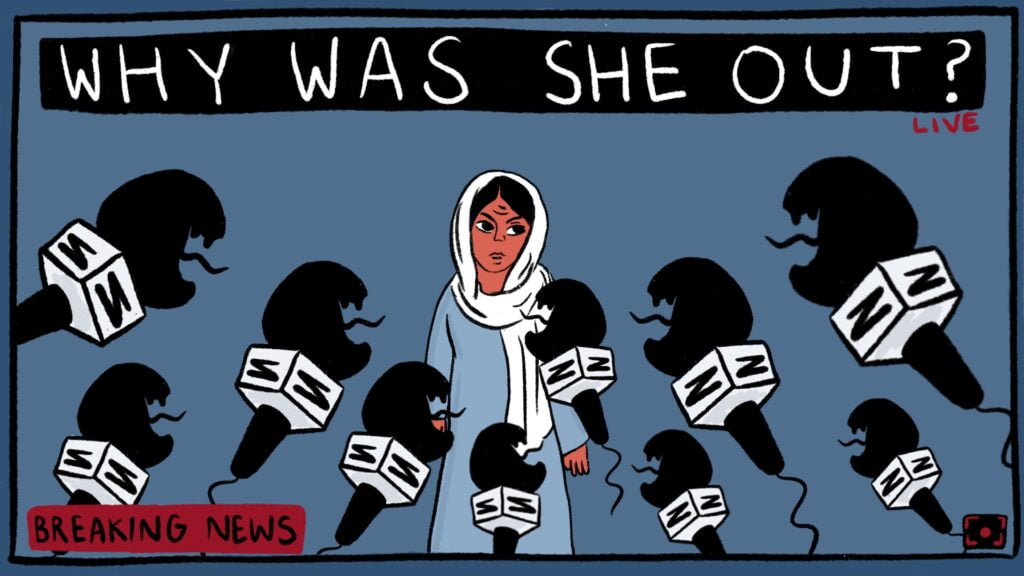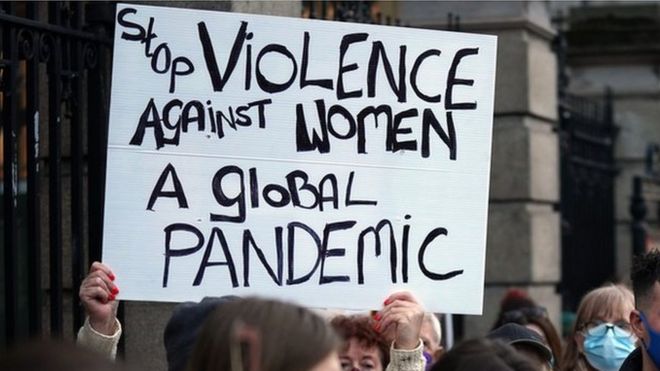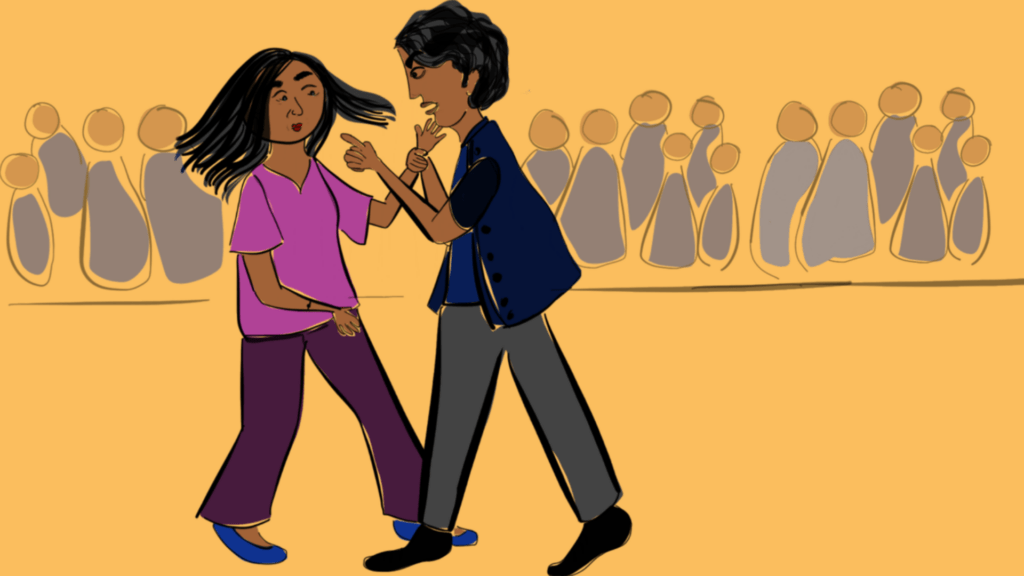Trigger Warning: Mention of intimate partner violence and murder
A 36-year-old woman identified as Chameli Yadav’s body was found in Padamla village of Vadodara in Gujarat on 17th February 2023 by the local police. Chameli was murdered and her remains were disposed of there. Investigations into the incident revealed that her live-in partner killed her. Reports concluded that she was staying with her partner Ajay Yadav for the last one month. Another case comes from the country’s capital New Delhi where Nikki Yadav, 23, was strangled by her partner Sahil Gehlot with a charging cable on 10th February. He then stuffed the body in a fridge at a restaurant owned by his family.
The report graph shows a total of 7739 female adult victims being murdered in the year 2021 while a total of 8405 female victims were murdered including children. The crime against women graph saw a surge in cases in the year 2021 with 428278 cases registered compared to 405326 cases and 371503 cases registered in the year 2019 and 2020 respectively. 284 cases were registered under murder with rape/gang rape, 6753 cases under dowry deaths, 5292 cases under abetment to suicide of women, 136234 cases under cruelty by husband or relatives and 507 cases under the protection of women from domestic violence act in the year 2021.
A similar incident happened last year where yet another victim Shraddha Walkar was murdered similarly by her live-in partner Aaftab Poonawalla, who chopped her body into pieces and stored them in a fridge before disposing of them across the city of New Delhi. Another victim in Rajasthan identified as Guddi January 20, was murdered by her ex-boyfriend who later dismembered her body before scattering her body parts at various locations. The victim was identified as a married woman from Balasar village in Rajasthan. Megha Dhan Singh Torvi, another 35-year-old victim was murdered by her live-in partner who she was in a relationship with for the past three years. Both were living together in a rented apartment in Mumbai’s Nalasopara for the last six months.
The National Commission for Women in India sought a police report in the case of the murder of Nikki Yadav by her live-in partner, Sahil Gehlot, and blamed families for intimate partner homicides in India. The chairperson of the National Commission for Women (NCW), Rekha Sharma, has emphasised the need for both the police and families to be concerned about the incidents related to live-in relationships. Ms Sharma urged families to accept live-in relationships and stated that the NCW will take all necessary actions in such cases.

The issue of women being killed by their partners is a serious and concerning problem that affects many individuals and communities around the world, and they are increasing at an alarming rate in India. This type of violence, which is often referred to as intimate partner homicide or femicide, is a form of gender-based violence and a violation of women’s human rights. Research shows that women are more likely to be killed by their intimate partners than men and that such violence is often the culmination of a pattern of abuse that includes emotional, physical, and sexual violence.
“The fact that femicide is not specifically recorded in India’s crime data highlights a disturbing lack of concern and understanding of gendered violence and its connections between the private and public spaces as well as necessary action needed towards all kinds of violence against women. Most of the different forms of violence against women in the family go unreported or underreported and invisible and when women access police intervention in cases of domestic violence, many cases of such domestic abuse are treated as non-cognizable offences.”
Nishi Mitra vom Berg, Professor, Tata Institute of Social Sciences
There are many factors that contribute to this problem, including gender inequality, patriarchal norms and values, and a lack of access to resources and support services for survivors. There is a significant body of research on intimate partner homicide or femicide that supports the statement that women are more likely to be killed by their intimate partners than men. This research has been conducted by various organisations and academic institutions and is based on the analysis of data from police reports, medical records, and other sources. The World Health Organization’s (WHO) multi-country study on women’s health and domestic violence against women, found that in most countries, intimate partner homicide accounts for the majority of female homicides.
The United Nations Office on Drugs and Crime (UNODC) Global Study on Homicide, found that in 2017, 87,000 women were killed globally, with more than half (58%) killed by intimate partners or family members. Another research conducted by the National Coalition Against Domestic Violence (NCADV), found that in the United States, more than half of all female homicide victims are killed by a current or former intimate partner.

These studies, and others like them, provide evidence of the prevalence and severity of intimate partner homicide or femicide and underscore the need for effective prevention, intervention, and support strategies to address this issue.
It’s concerning to note that in the year 2021, the National Crime Records Bureau of India reported a total of 132 cases, 3318 cases, 2849 cases and 1150 cases of murder for female victims between the ages of 16-18 years, 18 to 30 years, 30 to 45 years and 45-60 years respectively out of a total of 29272 murder cases registered in the year 2021. These numbers highlight the unfortunate reality of violence against women in our society. According to the NCRB report, of around 19 metropolitan cities including Ahmedabad, Bengaluru, Chennai, Coimbatore, Delhi City, Ghaziabad, Hyderabad, Jaipur, Indore, Kanpur, Kochi, Kolkata, Kozhikode, Lucknow, Mumbai, Nagpur, Patna, Pune and Surat, 179 women were killed aged between 18-30 years, while 149 women were murdered in the year 2021 ageing between 30-45 years.
Also read: Femicide In India: How Easy Is It To Kill A Woman?
The report graph shows a total of 7739 female adult victims being murdered in the year 2021 while a total of 8405 female victims were murdered including children. The crime against women graph saw a surge in cases in the year 2021 with 428278 cases registered compared to 405326 cases and 371503 cases registered in the year 2019 and 2020 respectively. 284 cases were registered under murder with rape/gang rape, 6753 cases under dowry deaths, 5292 cases under abetment to suicide of women, 136234 cases under cruelty by husband or relatives and 507 cases under the protection of women from domestic violence act in the year 2021.

Nishi Mitra vom Berg is a Professor at the Centre for Study of Developing Societies, School of Development Studies, at Tata Institute of Social Sciences (TISS), Mumbai, India. She exposes the inadequacy of India’s annual Crime in India Bulletin data in identifying and counting femicides.
She says, “The fact that femicide is not specifically recorded in India’s crime data highlights a disturbing lack of concern and understanding of gendered violence and its connections between the private and public spaces as well as necessary action needed towards all kinds of violence against women. Most of the different forms of violence against women in the family go unreported or underreported and invisible and when women access police intervention in cases of domestic violence, many cases of such domestic abuse are treated as non-cognizable offences.”
“It is only when the gross and grievous form of injuries get reported or women are murdered that this violence gets police and public notice, leaving the magnitude and extent of femicide unknown,” says Prof. Mitra in a conversation with FII.
Prof. Mitra also said that the definition of femicide is unclear in India and in other parts of the globe, as gender relations and culture make for its different forms globally. In India, it exists as honour crimes, dowry murders, murders of women for marrying outside of caste and religion, amniocentesis tests and abortion of female foetuses and death of girls by discrimination and abuse, etc. She said that global advocacy is needed to raise questions about each government’s accountability and responsibility towards women’s safety and human rights.

There needs to be an exercise involving government representatives, scholars and activists to understand how naming and proper categorising of data can help us in responding to homicides of women effectively in terms of preventive and corrective interventions. The Crime in India bulletin has such categories as “homicides”, “murder with rape”, “dowry deaths”, “female foeticide”, “female infanticide” and “suicide” that need for instance to be consolidated in the case of women and girl victims to understand how many women and girls are being murdered or die due to unnatural causes. These cases need to be studied in detail.
She also said that there is a lack of consistency in India’s National Crime Records Bureau’s data collection and classification over the years, making the comparability of data over years challenging. Prof. Nishi Mitra vom Berg is a trained Social-Cultural Anthropologist with experience in researching violence against women and other women’s issues for close to thirty years. She argues that the lack of clear information on why female victims were killed or died unnaturally demonstrates a concerning lack of understanding of gendered violence against women and girls, perpetuating its invisibility and institutionalisation and its surfacing every now and then in horrific forms that shake our belief in law and order.
The lack of proper data on femicides in India is a major issue, with no standardised method in place to accurately identify or count the number of women who are killed due to gender-based violence. Shockingly, such killings are recorded as regular homicides, further exacerbating the problem of underreporting and neglect of this serious issue. This lack of accountability and transparency is especially concerning, given the alarming rate at which women in India face violence, harassment, and discrimination. The failure to collect accurate data and analyse it appropriately makes it difficult to fully comprehend the extent of the problem and formulate effective solutions to address it.

Without accurate and reliable data, it is challenging to advocate for policy changes that can protect women and reduce the incidence of gender-based violence. This gap in knowledge is unacceptable, and it is high time for the Indian government and concerned authorities to prioritise the collection and analysis of data related to femicides in order to accurately reflect the reality of the situation and develop targeted interventions that can bring an end to this crisis. India’s National Crime Records Bureau (NCRB) releases annual reports listing homicide motives but fails to provide specific information on why female victims were killed. Furthermore, the number of female homicides does not match other figures in the report. This is partly due to the classification of cases involving multiple crimes.
As the UN secretary-general, António Guterres once said that the most ubiquitous infringement upon human rights is the violence perpetrated against women and girls. His solemn words ring with the truth that every 11 minutes, a woman or girl falls prey to the hands of an intimate partner or family member, leaving behind shattered lives and broken dreams.
Also read: Shraddha Walkar Murder: A Grave Reflection On Unaddressed Issue Of Intimate Partner Violence
To address this issue, it is important for communities and governments to take a multi-faceted approach that includes prevention, intervention, and support. This may involve initiatives such as education and awareness-raising campaigns, stricter laws and law enforcement to hold perpetrators accountable, and increased access to support services for survivors. It is also important to challenge cultural attitudes and beliefs that normalise violence against women and to promote gender equality and women’s rights.





What about women murdering their husbands, usually with the help of their lovers, which is common but not covered by mainstream media as it does not get TRPs. Also, you only need to watch Deepika Bharadwaj’s documentaries ‘Martyrs of Marriage’ and ‘India’s Sons’ to know how prevalent false cases of dowry and rape are, increasing men’s suicides and destroying their lives.
Misandry is so bad that crimes against men have to be covered on personal blogs. Men are silenced to the point where women like Deepika Bharadwaj and Arnaz Hathiram have to take up men’s issues.
voiceformenindia.com